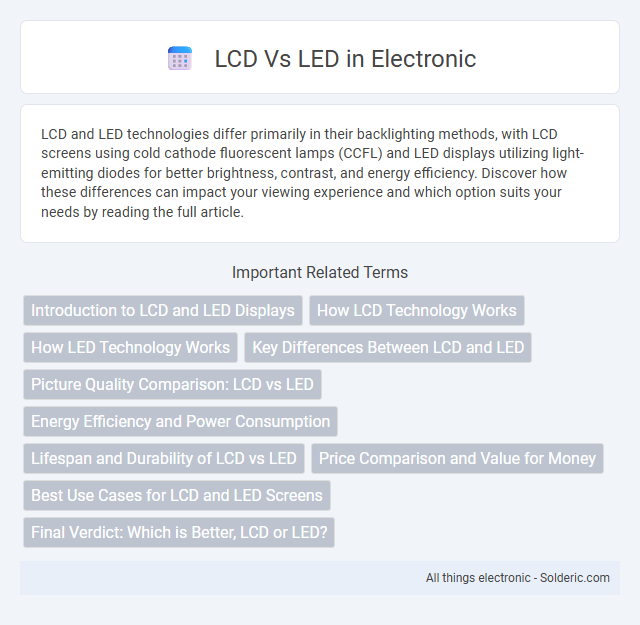LCD and LED technologies differ primarily in their backlighting methods, with LCD screens using cold cathode fluorescent lamps (CCFL) and LED displays utilizing light-emitting diodes for better brightness, contrast, and energy efficiency. Discover how these differences can impact your viewing experience and which option suits your needs by reading the full article.
Comparison Table
| Feature | LCD (Liquid Crystal Display) | LED (Light Emitting Diode) |
|---|---|---|
| Backlighting | Cold Cathode Fluorescent Lamps (CCFL) | Light Emitting Diodes |
| Energy Efficiency | Lower | Higher |
| Brightness | Average (300-400 cd/m2) | High (up to 1000 cd/m2) |
| Contrast Ratio | Typically 1000:1 | Better, up to 5000:1 or more |
| Thickness | Thicker due to CCFL | Thinner and lighter |
| Lifespan | 5,000 - 10,000 hours | 30,000+ hours |
| Color Accuracy | Good | Better with wider color gamut |
| Cost | Generally lower | Higher upfront, but cost-effective long-term |
| Environmental Impact | Contains mercury in CCFL | More eco-friendly |
| Usage | Older monitors and TVs | Modern monitors, TVs, smartphones |
Introduction to LCD and LED Displays
LCD (Liquid Crystal Display) and LED (Light Emitting Diode) displays are widely used technologies for screens in devices like TVs, monitors, and smartphones. LCD panels rely on liquid crystals manipulated by electric currents to control light passage, requiring a backlight, whereas LED displays use light-emitting diodes as the light source, offering better brightness and energy efficiency. Understanding the differences in backlighting and image quality helps you choose the right display technology for your needs.
How LCD Technology Works
LCD technology relies on liquid crystals that manipulate light to create images by blocking or allowing light to pass through pixels when electrically charged. A backlight, typically fluorescent or LED, shines through these crystals, and the orientation of the liquid crystals controls the amount of light reaching the screen, producing color and brightness variations. This method enables sharp image display with energy efficiency and slim panel design.
How LED Technology Works
LED technology works by using light-emitting diodes to produce light directly, unlike traditional LCDs that require a backlight. These diodes emit concentrated, energy-efficient light, resulting in brighter displays with higher contrast ratios and deeper blacks. Your viewing experience improves with faster response times and slimmer screen designs due to the compact nature of LED components.
Key Differences Between LCD and LED
LCD (Liquid Crystal Display) screens use fluorescent backlighting, while LED (Light Emitting Diode) displays utilize LED backlighting, resulting in differences in brightness, energy efficiency, and color accuracy. LED displays typically offer higher contrast ratios and thinner panels compared to traditional LCDs, as LED backlights can be controlled more precisely. The superior color range and lower power consumption make LED a preferred choice for modern screens in televisions, monitors, and smartphones.
Picture Quality Comparison: LCD vs LED
LED displays offer superior picture quality compared to traditional LCDs by utilizing light-emitting diodes for backlighting, resulting in higher contrast ratios, deeper blacks, and more vibrant colors. LCD panels rely on cold cathode fluorescent lamps (CCFLs) for backlighting, which often produce less uniform brightness and reduced color accuracy. To enhance your viewing experience, choosing an LED screen ensures sharper images and better dynamic range than standard LCD alternatives.
Energy Efficiency and Power Consumption
LED displays are more energy-efficient than traditional LCD screens because they use light-emitting diodes for backlighting, which consume less power while providing better brightness and contrast. LCD screens rely on cold cathode fluorescent lamps (CCFLs) for backlighting, resulting in higher power consumption and heat generation. This difference makes LED technology preferable for reducing electricity costs and environmental impact in various applications.
Lifespan and Durability of LCD vs LED
LED displays generally offer a longer lifespan and greater durability compared to traditional LCD screens due to their use of LED backlighting, which produces less heat and consumes less power. The average lifespan of LED TVs ranges from 50,000 to 100,000 hours, while LCDs typically last around 30,000 to 60,000 hours. If you prioritize longevity and reduced maintenance costs, choosing an LED display is a more reliable investment with enhanced durability under daily use.
Price Comparison and Value for Money
LED TVs typically offer better energy efficiency and improved picture quality compared to traditional LCDs, often at a slightly higher price point. While LCD TVs are usually more affordable upfront, LED models provide greater long-term value through enhanced brightness, contrast, and lifespan. Choosing an LED TV can be a smarter investment for your budget if you prioritize durability and superior display performance.
Best Use Cases for LCD and LED Screens
LCD screens excel in environments requiring natural color accuracy and consistent brightness, such as graphic design, medical imaging, and office work where detailed visuals are essential. LED screens are ideal for outdoor advertising, gaming, and home theaters due to their superior contrast ratios, energy efficiency, and ability to produce vibrant colors and deep blacks. Choosing between LCD and LED depends on factors like lighting conditions, color precision needs, and power consumption priorities.
Final Verdict: Which is Better, LCD or LED?
LED displays generally offer better picture quality, energy efficiency, and slimmer designs compared to traditional LCDs, making them the preferred choice for most users. While both use liquid crystal technology, LEDs use light-emitting diodes for backlighting, resulting in improved contrast and color accuracy. Your decision should prioritize LED panels for superior performance and long-term satisfaction.
LCD vs LED Infographic

 solderic.com
solderic.com